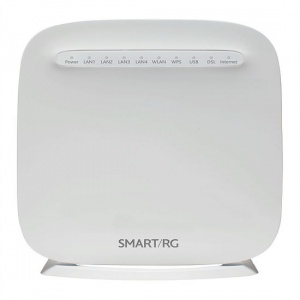Difference between revisions of "SmartRG SR505N Configuration"
(Created page with 'thumb|right|300px|The SmartRG SR505N Modem Front thumb|right|300px|The SmartRG SR505N Modem Back This is the procedure NCF uses…') |
(spacing) |
||
| Line 2: | Line 2: | ||
[[File:sr505n_back.jpg|thumb|right|300px|The SmartRG SR505N Modem Back]] | [[File:sr505n_back.jpg|thumb|right|300px|The SmartRG SR505N Modem Back]] | ||
This is the procedure NCF uses to configure a SmartRG SR505N modem out of the box or after a factory reset. To learn more about configuring your particular modem, consult the [[Modem manuals (DSL)|manual]]. | This is the procedure NCF uses to configure a SmartRG SR505N modem out of the box or after a factory reset. To learn more about configuring your particular modem, consult the [[Modem manuals (DSL)|manual]]. | ||
=== Configure as router for VDSL === | === Configure as router for VDSL === | ||
| Line 40: | Line 38: | ||
=== Configure as bridge === | === Configure as bridge === | ||
# Connect power and turn on the modem with the black button on the back. | # Connect power and turn on the modem with the black button on the back. | ||
# Connect an Ethernet LAN cable to one of the yellow rear ports | # Connect an Ethernet LAN cable to one of the yellow rear ports | ||
| Line 68: | Line 65: | ||
=== Wireless Configuration === | === Wireless Configuration === | ||
Continuing now to set the '''Wireless''' configuration | Continuing now to set the '''Wireless''' configuration | ||
# Ensure '''Enable Wireless''' is checked | # Ensure '''Enable Wireless''' is checked | ||
| Line 99: | Line 95: | ||
File:smartrg_505n_adsl14.png|Setting Admin Password | File:smartrg_505n_adsl14.png|Setting Admin Password | ||
</gallery> | </gallery> | ||
== See also == | == See also == | ||
Revision as of 09:25, 26 September 2014
This is the procedure NCF uses to configure a SmartRG SR505N modem out of the box or after a factory reset. To learn more about configuring your particular modem, consult the manual.
Configure as router for VDSL
This section is for configuring your router for VDSL connections. These include the following NCF DSL Plans:
- Freedom 15-10/300
- Freedom 25/300
- Freedom 50/300
- Smartrg 1.jpg
Configuring VDSL 1/5
- Smartrg 2.jpg
Configuring VDSL 2/5
- Smartrg 3.jpg
Configuring VDSL 3/5
- Smartrg 4.jpg
Configuring VDSL 4/5
- Smartrg 5.jpg
Configuring VDSL 5/5
Configure as router for ADSL
This section is for configuring your router for ADSL2+ connections. These include the following NCF DSL Plans:
- Freedom 6/300
- Freedom 7/300
- Freedom 15-1/300
- Smartrg 505n adsl01.png
Configuring ADSL2+ 1/11
- Smartrg 505n adsl02.png
Configuring ADSL2+ 2/11
- Smartrg 505n adsl03.png
Configuring ADSL2+ 3/11
- Smartrg 505n adsl04.png
Configuring ADSL2+ 4/11
- Smartrg 505n adsl05.png
Configuring ADSL2+ 5/11
- Smartrg 505n adsl06.png
Configuring ADSL2+ 6/11
- Smartrg 505n adsl07.png
Configuring ADSL2+ 7/11
- Smartrg 505n adsl08.png
Configuring ADSL2+ 8/11
- Smartrg 505n adsl09.png
Configuring ADSL2+ 9/11
- Smartrg 505n adsl10.png
Configuring ADSL2+ 10/11
- Smartrg 505n adsl11.png
Configuring ADSL2+ 11/11
Configure as bridge
- Connect power and turn on the modem with the black button on the back.
- Connect an Ethernet LAN cable to one of the yellow rear ports
- In the browser's address bar, enter the IP address for the modem interface page: 192.168.1.1
- If the modem is fresh from the factory, use the default user name and password to gain access
- user: admin
- password: admin
If the modem was previously configured for someone, the password would be the previous user's DSL-Password. If it is unknown then do a reset to factory default, using a paper-clip in the reset hole on the back. Hold for 15 seconds to reset. The user name and password will now be as above.
- Click on Advanced Setup and WAN Service and click on Add
- The defaults are fine; click on Next.
- Click on Bridging and ensure the 802.1P and 802.1Q are set to 0 and 35, then click on Next.
- Click on Apply/Save
- Done!
See screenshots below:
- Smartrg 505n bridge 1.png
Configuring for Bridge Mode 1/5
- Smartrg 505n bridge 2.png
Configuring for Bridge Mode 2/5
- Smartrg 505n bridge 3.png
Configuring for Bridge Mode 3/5
- Smartrg 505n bridge 4.png
Configuring for Bridge Mode 4/5
- Smartrg 505n bridge 5.png
Configuring for Bridge Mode 5/5
Wireless Configuration
Continuing now to set the Wireless configuration
- Ensure Enable Wireless is checked
- The SSID is set to NCF plus a random number, such as NCF_123456. It is recommended you not use your first or last name, or street address as this information is broadcast and other people in your area will be able to associate the signal with which home it is coming from.
- Click on Apply/Save at the bottom.
- Click on Security on the left.
- Set the Network Authentication to Mixed WPA2/WPA-PSK
- Uncheck Use base MAC address as WPA/WAPI passphrase
- Set the WPA/WAPI passphrase to be your DSL-Password
- Click Apply/save.
- Smartrg 505n adsl12.png
Configuring Wireless 1/2
- Smartrg 505n adsl13.png
Configuring Wireless 2/2
Password protect the Admin Role
- Click on Management on the left. Below it other options appear.
- Select Access Control
- Select Passwords
- Enter admin for the User Name
- Enter admin for the Old Password
- For the New Password use your DSL-Password or another strong password.
- Enter it once and again below to confirm
- Save the changes with Apply/Save
A pop-up log-in screen appears, and asks for sign-in. Use the User-ID admin and the DSL-Password just set. Return to the same configure page you were just at.
- Smartrg 505n adsl14.png
Setting Admin Password
See also
- Dynamic DNS
- Modem Configuration (DSL) - for a complete list of instructions for all NCF modems
- Port forwarding


